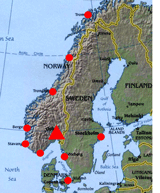Norway Convenes Barcoding Collections Symposium

Representatives from 15 natural history museums and research institutions in Norway, Sweden, and Denmark gathered at Oslo Natural History Museum on 20-21 March 2006 to discuss the role genetic resource collections in the Barcoding of Life Initiative. Lutz Bachmann, Arild Johnsen, Jan T. Lifjeld, and Jon Lonnve organized an enjoyable and productive meeting, including many well-timed coffee breaks! There was general enthusiasm about museums joining in a collective effort, the public and scientific importance of genetic collections and natural history museums in understanding and preserving biodiversity, and the Barcoding of Life Initiative. As an initial step, the Natural History Museum in Oslo plans to barcode Norwegian birds, drawing on its 10,000+ samples of avian tissues. For more information contact Jan T. Lifjeld (j.t.lifjeld@nhm.uio.no).
Locations of natural history museums represented at Oslo meeting
This entry was posted on Saturday, March 25th, 2006 at 11:25 pm and is filed under AllBirds, General. You can follow any responses to this entry through the RSS 2.0 feed. Both comments and pings are currently closed.